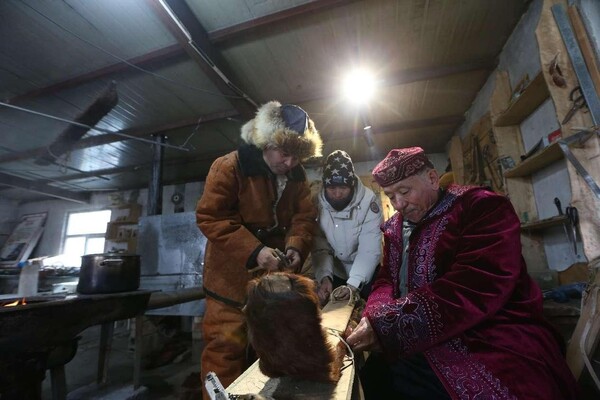By Khuwanishbek Islanbek
Timber and horsehide are piled high in the yard. Inside my house, steam rises as the iron pot on the fire stove boils water. Wooden planks slowly soften in the hot water, transforming into materials for me to make ancient fur skis.
As an inheritor of the ancient fur ski-making technique, I return to this little house in Lasite township in Altay, Xinjiang Uygur autonomous region once winter arrives, bringing along a few young people from the village to make ancient fur skis for tourists.
My father, Islanbek Shaghish, is an inheritor of this ski-making technique at the autonomous region level. I have been learning to make ancient fur skis from him since I was young.

Back then, my father told me that making ancient fur skis requires great attention to detail. From selecting and making the wooden planks, to soaking and cleaning the horsehide, every single detail requires the craftsman's full devotion.
In Altay, known as the "origin of human skiing activities," ancient fur skis were once a must-have means of transportation in winter. As time goes by, fur skiing has now become a competitive sport and tourist activity. In recent years, ancient fur skis have been deeply explored and have become a signature for Altay to promote ice and snow tourism and culture.
As Altay's ancient fur skis became more and more famous, gradually more people came to visit our house and purchase our skis. My father became increasingly busy. Seeing so many people like our ancient fur skis, I felt very proud. So in 2021, I sold my taxi and came back to inherit this ancient craft.

The ancient fur ski-making technique has been passed down to me for five generations. Under my father's patient guidance, my mastery of this skill has gradually deepened and I have accumulated some experiences. However, when making fur skis, I still find many inadequacies. I still need to learn how to select the best timber and horsehide, and how to make soft yet sturdy cowhide ropes.
At the 16th Xinjiang Winter Tourism Industry Trade Expo and the first regional winter games, our ancient fur skis were recognized and praised by visitors from all over the world. This greatly encouraged me and motivated me to carry on.
Now, more than just bringing income to my family, I'm striving to pass down this age-old technique. I've taught some young people in my village. During the tourism season in winter, we take orders together. A pair can sell for over 1,000 yuan ($138.94), so everyone earns a decent income. Apart from regular-sized skis, we also design and produce palm-sized miniature skis for tourists, which are ornamental and easy to carry.
Moving forward, I will keep studying and making innovations. By combining modern skiing technology elements with ancient fur skis, I will strive to revitalize this ancient craft, allowing the time-honored skiing culture with its historical heritage to radiate with new splendor.
(Khuwanishbek Islanbek is an inheritor of the ancient fur ski-making technique in Altay, Xinjiang Uygur autonomous region. This article was written by People's Daily journalist Li Ya'nan based on an interview.)


